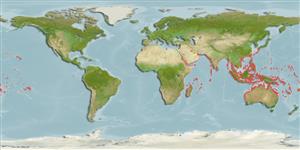>
Mugiliformes (Mullets) >
Mugilidae (Mullets)
Etymology: Crenimugil: Latin, crenulatus = cut, clipped + Latin, mugil = grey mullet (Ref. 45335).
More on author: Forsskål.
Environment: milieu / climate zone / depth range / distribution range
นิเวศวิทยา
เกี่ยวกับทะเล,น้ำเค็ม; กร่อย เกี่ยวกับหินโสโครก; ไม่มีการอพยพย้ายถิ่น; ระดับความลึก 0 - 20 m (Ref. 89972). Tropical; 32°N - 32°S, 32°E - 143°W
Indo-Pacific: Red Sea and East Africa to the Line and Tuamoto islands, north to southern Japan, south to Lord Howe Island.
ขนาด / น้ำหนัก / Age
Maturity: Lm ? range ? - ? cm
Max length : 60.0 cm TL เพศผู้/กระเทย; (Ref. 9710); common length : 26.0 cm SL เพศผู้/กระเทย; (Ref. 9812)
เงี่ยงครีบหลัง (รวม) : 4 - 5; ก้านครีบอ่อนที่หาง (รวม) : 9 - 10; เงี่ยงครีบก้น: 3; ก้านครีบอ่อนที่ก้น: 8 - 10. Silvery in color, greenish olive above; pectoral fins pale yellow with purplish axillary spot, other fins grey (Ref. 4393).
Found in coastal waters, over sandy or muddy areas of lagoons, reef flats and tide pools; enters harbors (Ref. 9812). Schooling species, swim at various depths along reefs, to about 20 meters but usually much shallower. Feed on detritus containing algae and microscopic animals, by scooping up the upper layer of sand or mud and filtering through the gills (Ref. 48637). Omnivorous (Ref. 6113). Form large schools before spawning, at the beginning of the ebb tide (in June), over shallow, open areas of the lagoon slope (Ref. 9812). Oviparous, eggs are pelagic and non-adhesive (Ref. 205). Spawning occurs in large aggregations after dark. Marketed fresh (Ref. 9812). Minimum depth reported taken from Ref. 30874.
Randall, J.E., G.R. Allen and R.C. Steene, 1990. Fishes of the Great Barrier Reef and Coral Sea. University of Hawaii Press, Honolulu, Hawaii. 506 p. (Ref. 2334)
IUCN Red List Status (Ref. 130435)
Threat to humans
Reports of ciguatera poisoning (Ref. 130160)
Human uses
การประมง: มีการค้าเพียงเล็กน้อย; การเพาะเลี้ยงสัตว์น้ำ: การค้า; เหยื่อ: occasionally
เครื่องมือ
Special reports
Download XML
แหล่งที่มาจากอินเตอร์เน็ต
Estimates based on models
Preferred temperature (Ref.
123201): 24.6 - 29.3, mean 28.3 °C (based on 3397 cells).
Phylogenetic diversity index (Ref.
82804): PD
50 = 0.5625 [Uniqueness, from 0.5 = low to 2.0 = high].
Bayesian length-weight: a=0.01622 (0.01033 - 0.02547), b=2.96 (2.83 - 3.09), in cm total length, based on LWR estimates for this species & (Sub)family-body (Ref.
93245).
ระดับชั้นอาหาร (Ref.
69278): 2.3 ±0.10 se; based on food items.
ความสามารถในการกลับคืนสู่ปกติ (Ref.
120179): ความสูง, เวลาต่ำสุดที่จะทำให้ประชากรเพิ่มขึ้นเป็น 2 เท่าใช้เวลาน้อยกว่า 15 เดือน (Fec=195,000-897,000).
Fishing Vulnerability (Ref.
59153): Moderate vulnerability (44 of 100).
Nutrients (Ref.
124155): Calcium = 45.7 [18.2, 140.3] mg/100g; Iron = 0.585 [0.273, 1.350] mg/100g; Protein = 18.9 [17.1, 20.7] %; Omega3 = 0.172 [0.087, 0.355] g/100g; Selenium = 31.8 [16.7, 67.7] μg/100g; VitaminA = 55 [14, 220] μg/100g; Zinc = 1.68 [1.09, 2.55] mg/100g (wet weight);
